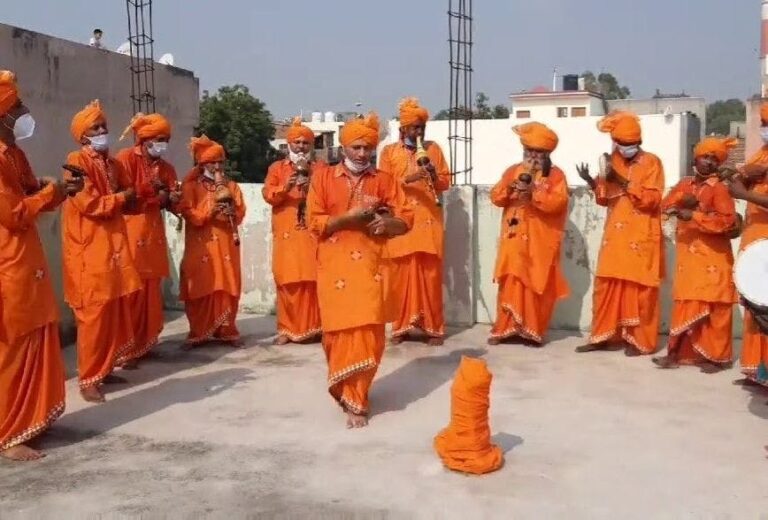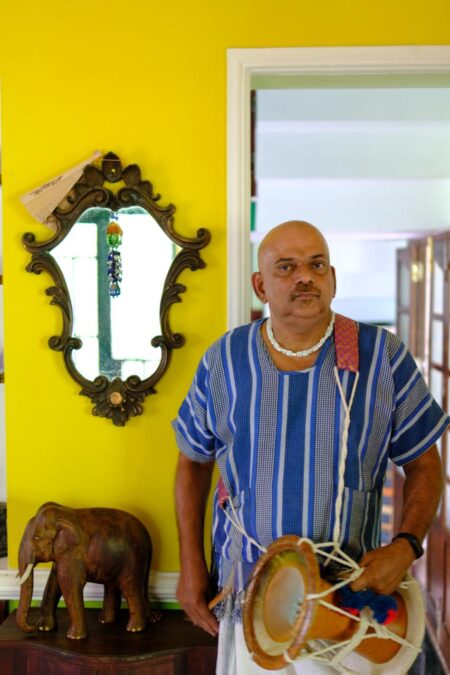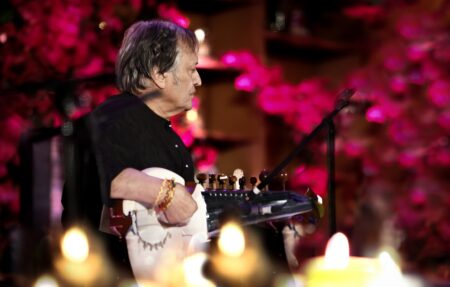The snake charmers or the ‘saperas’ are reinventing themselves by playing the same music to a different audience: humans
Abunch of saffron-clad saperas or snake charmers playing their ‘Pungi’ or ‘Makudi’ (a folk-based wind instrument) haunted instagrammers recently. Their mesmerising music accompanied with ‘ektaras’, a one stringed musical instrumentand ‘dhols’, a double-sided barrel drum, revived a primal and raw energy inside everyone. Surprisingly there are several ‘Sapera Bands’ in and around New Delhi. One of the key reasons for forming these bands could be the introduction of the Wildlife (Protection) Act of 1991, which prohibits keeping any wild animal in captivity or for any other purpose. This has resulted in the saperas and their professions being obsolete. Since snake charming is the only art and skill they know, a few snake charmers, as an alternative, have formed bands for entertaining the public with the ‘Been’ or ‘Pungi’ that could bring in some income and help them in their hand-to-mouth existence.
Chabram Singh, a former snake charmer, now runs his wedding band — The Nagin band — which is in big demand during the wedding season. Singh, who runs a 24-member team, has performed at many prestigious venues including 5-star hotels. The business booms around Nagapanchami and Shivaratri, according to Singh. Sindhi Pradhan another old snake charmer has included new bass drums and flute in his band along with a horse buggy and a chandelier. He charges 40,000 per performance.
Like Singh and Pradhan, there are many Saperas, originally from Rajasthan, settled in Mania village of Uttar Pradesh (also known as Sapera Basti), who are now running bands. Music and snakes are an inseparable part of their lives for generations.
Mythology around Nagas
Growing up in a traditional South Indian family granted me the luxury of nurturing my imagination by listening to the intriguing and bone-chilling tales of Nagas, the serpents.
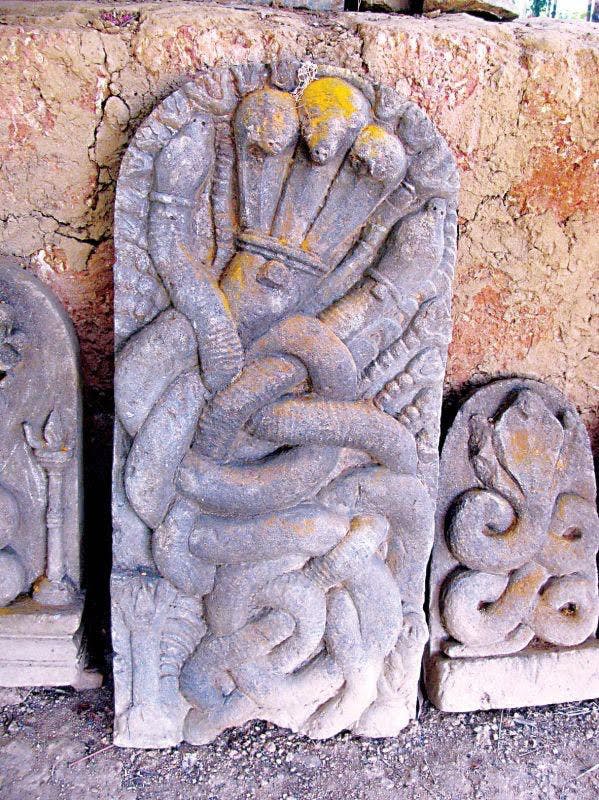
The Hindu mythology is resplendent with nature-worshipping where all forms of nature and its elements are celebrated and revered. Among them, snakes and elephants stand apart and various explanations and suggestions for this have come up in the past few decades. Whether it is the epics or the cave murals and sculptures in Ajanta and Ellora caves or the numerous carvings that cover up the temple arcades, coiling serpents and half-man-half-snake figurines intimidate the prominence ascertained for this particular species. The Puranas or the mythologies have ascertained an entire world itself for the Nagas under the earth where sunlight never enters but is beautifully lit with the light emanating from the ‘Nagamanikyam’ or the jewel that adorns their heads. In some households including mine, elders often remind to not eat or sleep while the sun is setting as it is believed one would be cursed to be reborn as ‘Ananthan’ in the next life. The fear that is instilled in the minds of people with the image of a snake is gargantuan.
The sacred groves (the strip of virgin forest) maintained in almost all the parts of the sub-continent has a multi-faceted implication in the prevalent culture and beliefs. The concept of keeping aside a space for the flora and fauna and later to serpents exclusively functions as a pedagogical apparatus too. The task of driving home the truth about protecting nature in every possible way has been successfully implemented with the maintenance of such structures. These groves on the southernmost tip of the peninsula is abundant with stone relics and structures and are commonly referred as ‘Chithrodakkallu’ (stone figurines inside the groves).

Most of the families maintain such spaces where no cultivation or human presence is felt. The energy possessed and emanated from a snake is supposed to be three dimensional where an altogether different realm of active spirit resides in a snake other than the vertical and the horizontal. These stone structures too imply this three-dimensional aspect with its three-sided and triangular designs. Even the fear associated with the snakes can be considered the fear of the unknown. It is always creepy to walk in a knee-length grassy land!
The aural aspect connected to snake reverence is equally interesting. The snake charmers in the southern part of India (to be precise, Kerala) are usually called ‘Pulluvar’ or the female version ‘Pulluvathi’.
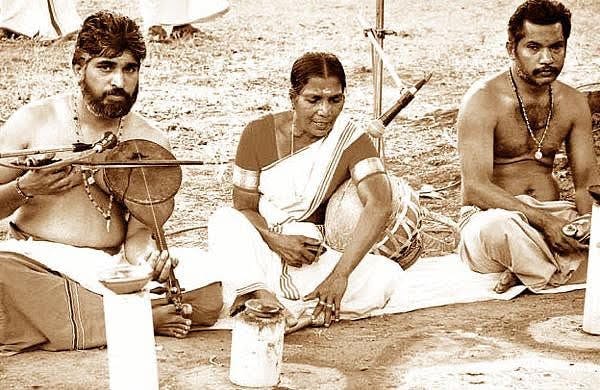
The ‘Pulluvan Pattu’ or the song rendered by them is believed to have the magic or the potency to ward off evil or alleviate your ‘dosha’ or the bad karma. The instruments like the ‘Veena’ or the ‘kudam’ and ‘thaalam’ have got that potentiality to invoke the carnal and the basic rhythm believed to be inherent and subdued inside us. The strumming of the strings and the incantation rendered by the singers has this hypnotic quality that may transport few into a trance and later into a kind of hysteria. Even the songs sung by them are somewhat like a conjuring up of the basic and the primal instincts inside us.
The mesmerising music
The Saperas, on the other hand, are more into the aesthetic element and is connected to the snake and its movements. Being called as ‘the land of snake charmers’, ‘Kalbeliyas’ or the Saperas is largely part of that ‘oriental gaze’ where the East/Orient has been an area of discourse for the West/Occident. Haggard looking men playing their flutes and the snake dancing to the tune symbolises that exotic element that got restricted due to various laws and policies and finally to marginalisation. The loss of cultural articulation connected to the prohibition of snake jugglery has forced this particular community to socio-economic disparage.
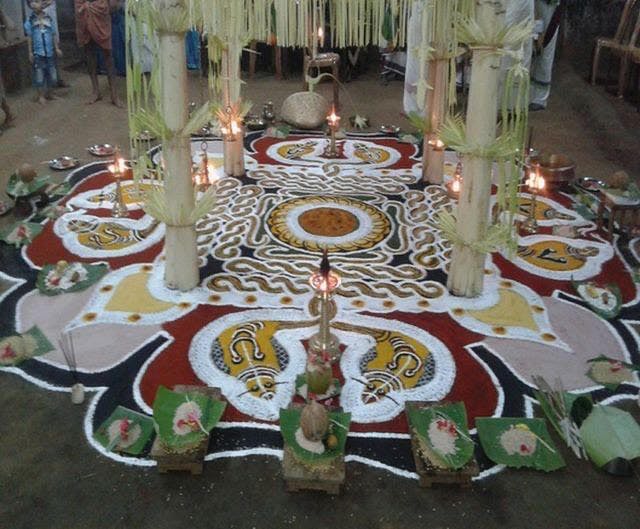
The visual aspect connected to snake worshipping includes the drawing of entwined snakes using vibrant and colorful powders on the ground and the ritualistic element connected to it is that of the general appeasement and the improvement of fertility and even virility. The hypnotic colours along with the lyrical incantation using the traditional gadgets often results in a mass hysteria where people usually women start getting frenzy. In certain areas, only girls who haven’t reached puberty are selected for the ritual but usually women participate actively in this worshipping cult. The vibratory effect of the music makes the girls enter an induced trance where they swing their hair and will start rubbing the ‘Kalam’ or the drawing. The Oracle effect associated with this ritual is highly interesting since the girls, while in this trance, speak an entirely unknown language and informs the onlookers matters concerning the snake-gods. Even the show biz like cinema too is not devoid of snake women. Nobody can forget the famous snake dance of late actress Sridevi in her movie Nagina. The snake eyes and slithery movements of the woman in tune to the Pungi had been a blockbuster of all times. Almost any culture before BC shows signs of snake worship but the influence of Hinduism over Buddhism has resulted in the migration of snake rituals into the South-East Asian culture vehemently. Especially in the Chinese culture and mythology, snakes and snake-like entities are ordained with numerous parts like that of in the calendar, literature, poetry, paintings and even as enactments.
The birth of the new digital age in India has drastically altered the cultural ethnography of the nation and has pushed this vulnerable snake-charmer community into the margins of criminal scrutiny and prohibition. That is why people such as Chabram Singh and Rajkumar Sapera started to form bands and playing their ‘Been’ for wedding barats and other such auspicious occasions. The only change is that instead of snakes, humans are dancing to the tune, and who wouldn’t miss the high-pitched and mesmerising music that will drift you into an intoxicated trance!

